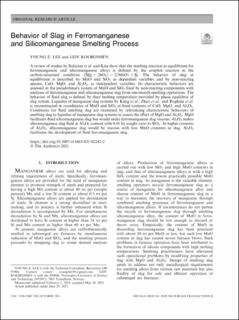Behavior of Slag in Ferromanganese and Silicomanganese Smelting Process
Peer reviewed, Journal article
Published version

Åpne
Permanent lenke
https://hdl.handle.net/11250/2978962Utgivelsesdato
2021Metadata
Vis full innførselSamlinger
- Institutt for materialteknologi [2544]
- Publikasjoner fra CRIStin - NTNU [37962]
Originalversjon
Metallurgical and Materials Transactions B. 2021, 52B (5), 3142-3150. 10.1007/s11663-021-02242-2Sammendrag
A review of studies by Safarian et al. and Kim show that the smelting reaction at equilibrium for ferromanganese and silicomanganese alloys is defined by the coupled reaction in the carbon-saturated condition 2Mn––––+(SiO2)=2(MnO)+Si––. The behavior of slag at equilibrium is described by MnO and SiO2 as dependent variables and by non-reacting species, CaO, MgO, and Al2O3, as independent variables. Its characteristic behaviors are assessed in the pseudobinary system of MnO and SiO2 fixed by non-reacting components with analyses of ferromanganese and silicomanganese slag from one-month smelting operations. The behavior of fluid slag is defined by their melting temperature provided by phase equilibria of slag system. Liquidus of manganese slag systems by Kang et al., Zhao et al., and Roghani et al. is reconstructed in coordinates of MnO and SiO2 at fixed contents of CaO, MgO, and Al2O3. Conditions for fluid smelting slag are examined by referencing characteristic behaviors of smelting slag to liquidus of manganese slag systems to assess the effect of MgO and Al2O3. MgO facilitates fluid silicomanganese slag but would make ferromanganese slag viscous. Al2O3 makes silicomanganese slag fluid at Al2O3 content with 0.41 by weight ratio to SiO2. At higher contents of Al2O3, silicomanganese slag would be viscous with low MnO contents in slag. Al2O3 facilitates the development of fluid ferromanganese slag.
